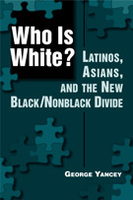In Florida, a Death ForetoldPosted in Articles, Latino Studies, Media Archive, Social Science, United States on 2013-07-15 02:52Z by Steven |
The New York Times
2012-03-31
In the mid-1930s, a Yale anthropologist ventured to an unnamed town in the South to explore the feudal divisions of what we commonly call race but what he preferred to describe with the more layered language of caste. When he arrived — white, earnest and fresh from the North — white Southerners told him that a Northerner would soon enough “feel about Negroes as Southerners do.” In making that prediction, the anthropologist John Dollard wrote in his seminal study “Caste and Class in a Southern Town,” they are saying “that he joins the white caste. The solicitation is extremely active, though informal, and one must stand by one’s caste to survive.”
Americans tend to think of the rigid stratification of caste as a distant notion from feudal Europe or Victorian India. But caste is alive and well in this country, where a still unsettled multiracial society is emerging from the starkly drawn social order that Dollard described. Assumptions about one’s place in this new social order have become a muddying subtext in the case of Trayvon Martin, the unarmed black teenager slain at the hands of an overzealous neighborhood watch captain, who is the son of a white father and a Peruvian mother.
We do not know what George Zimmerman was thinking as he watched Mr. Martin from afar, told a 911 dispatcher that he looked suspicious and ultimately shot him. But we do know that it happened in central Florida, a region whose demographic landscape is rapidly changing, where unprecedented numbers of Latino immigrants have arrived at a place still scarred by the history of a vigilante-enforced caste system and the stereotypes that linger from it. In this context, newcomers — like previous waves of immigrants in the past — may feel pressed to identify with the dominant caste and distance themselves from blacks, in order to survive…
…On the other hand, almost three-quarters of blacks felt that Latinos were hard-working or could be trusted. Black Americans appear to view Latinos as more like themselves. “Blacks are not as negative toward Latinos as Latinos are toward blacks because blacks see them as another nonwhite group that will be treated as they have been,” said Paula D. McClain, the lead author on the study. Even as blacks worry about losing jobs to new immigrants, they are less supportive of harsh anti-immigration laws, she said, “because they know what laws have done to them.”
But shared hardships don’t necessarily make allies. “As linked fate rises, so does competition,” said Michael Jones-Correa, a professor of government at Cornell who specializes in immigration and interethnic relations. “It’s like a sibling rivalry,” he said. “This is not a painless relationship.” And, of course, Latino immigrants don’t just enter a pre-existing racial hierarchy; they bring with them their own assumptions based on the hierarchies in their home countries. “When we come to the U.S.,” Eduardo Bonilla-Silva, a professor of sociology at Duke, who is Puerto Rican, said, “we immediately recognize whites on top and blacks on the bottom and say, ‘My job is to be anything but black.’ ”…
Read the entire opinion piece here.

